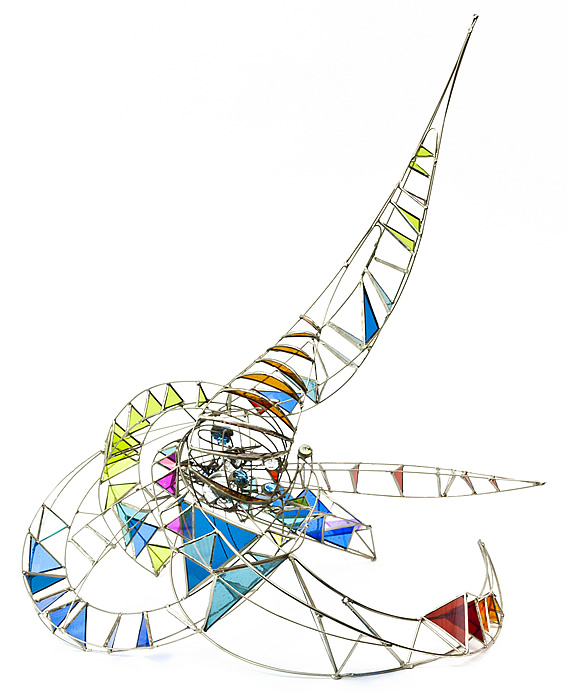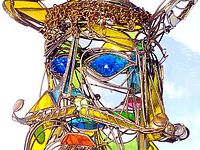Sculpture in the Round
Sculpture in the Round
There is no surface for stained glass color to flow onto. Like a picture puzzle, it must be constructed, each piece of colored glass cut to shape and fixed into a supporting matrix or armature.
A wooden frame, round or square, is required to enclose the composition and to give depth and support. Brass rod inserted in the frame at various levels takes the place of the armature in medieval stained glass windows. The support and linear expression of the design begins with bending the brass rod. Connecting various levels adds strength. Once the design becomes self-supporting, glass pieces can be cut and bound with foil to be soldered into the armature. Natural light floods the interior to enhance the contrast between the intensity of clear and colored light.
Elements
Instead of soldering glass together in a flat plain, I separated and superimposed them to produce a design of subtle variations in color. The space between pieces allows light to come through and become part of the composition.
Elements

- On exhibit at the Weston Public Library
- Featured in Color & Light
- Ask us about Elements
Lemondrop
Lemondrop

- Artist's collection
- Featured in Spontaneous Design
- Ask us about Lemondrop
Spring Dance
Spring Dance
- Artist's collection
- Featured in Stained Glass & Sculpture
- Ask us about Spring Dance
Sound of leaves singing
Isabel Ferguson
dry earth wakened, murmuring
small summer rain.

Carnival

Carnival
- Artist's collection
- Ask us about Carnival
Reliance on color and structure of stained glass alone allowed for freedom of personal interpretation.
Crucible
Working on a small cube sculpture, I wondered what it would be like to be inside the cube or any glass structure, looking out.
Crucible

- Artist's collection
- Featured in Color & Light
- Ask us about Crucible
Forth Bridge
Forth Bridge
- Artist's collection
- Featured in They Speak!
- Ask us about Forth Bridge
Opened in 1890, the Forth Bridge is a Scottish icon that is recognised the world over as the most famous of cantilever designs. (TheForthBridges.org)


Green Ball
Green Ball
- Artist's collection
- Featured in Stained Glass & Sculpture
- Ask us about Green Ball
Art used me.


Klingon
Klingon

- Artist's collection
- Ask us about Klingon
Sun Spot
Sun Spot
- Artist's collection
- Featured in Stained Glass & Sculpture
- Ask us about Sun Spot


Flower Garden
Flower Garden

- Artist's collection
- Featured in Glass & Rod
- Ask us about Flower Garden
























